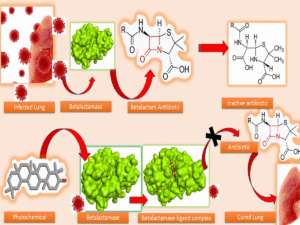3Department of Chemistry, St. Thomas College (Autonomous), Thrissur, India-680001 (Affiliated to University of Calicut) 4Department of Chemistry, Mother Arts and Science College Peruvallur, India- 680508 (Affiliated to University of Calicut)
5Department of Chemistry, St. Mary’s College Thrissur, India-680020 (Affiliated to University of Calicut)
* Correspondence to:reejajoh@gmail.com
Abstract
 The rise of beta-lactamase-producing bacteria poses a significant threat in healthcare. These bacteria render common antibiotics ineffective, necessitating stronger options with potentially harsher side effects. To combat these resistant strains, researchers are exploring two avenues: developing new antibiotics and creating drugs that inhibit beta-lactamase activity. This study focused on the anti-beta-lactamase potential of 27 phytochemicals against class A Extended-Spectrum Beta-Lactamases (ESBLs) of Klebsiella pneumoniae, specifically CTX-M-15, SHV-1, SHV-2 and KPC-2, using molecular docking simulations. Docking analysis and ADME (Absorption, Distribution, Metabolism, and Excretion) predictions were performed using CB-Dock v.2 and SwissADME web servers, respectively. Phytochemicals derived from Brideliastipularis, Andrographis paniculata, quercetin derivatives, and withanolides were screened for their inhibitory activity against beta-lactamases. Interestingly, withanolides, a class of steroidal compounds, displayed high inhibition potential. Among these, withanolide B exhibited remarkable inhibitory activity against three beta-lactamase enzymes, with the SHV-2-withanolide B complex demonstrating a binding score of -10.2 kcal/mol. This study primarily discusses phytochemicals with high binding scores and favorable drug-like properties.
The rise of beta-lactamase-producing bacteria poses a significant threat in healthcare. These bacteria render common antibiotics ineffective, necessitating stronger options with potentially harsher side effects. To combat these resistant strains, researchers are exploring two avenues: developing new antibiotics and creating drugs that inhibit beta-lactamase activity. This study focused on the anti-beta-lactamase potential of 27 phytochemicals against class A Extended-Spectrum Beta-Lactamases (ESBLs) of Klebsiella pneumoniae, specifically CTX-M-15, SHV-1, SHV-2 and KPC-2, using molecular docking simulations. Docking analysis and ADME (Absorption, Distribution, Metabolism, and Excretion) predictions were performed using CB-Dock v.2 and SwissADME web servers, respectively. Phytochemicals derived from Brideliastipularis, Andrographis paniculata, quercetin derivatives, and withanolides were screened for their inhibitory activity against beta-lactamases. Interestingly, withanolides, a class of steroidal compounds, displayed high inhibition potential. Among these, withanolide B exhibited remarkable inhibitory activity against three beta-lactamase enzymes, with the SHV-2-withanolide B complex demonstrating a binding score of -10.2 kcal/mol. This study primarily discusses phytochemicals with high binding scores and favorable drug-like properties.
